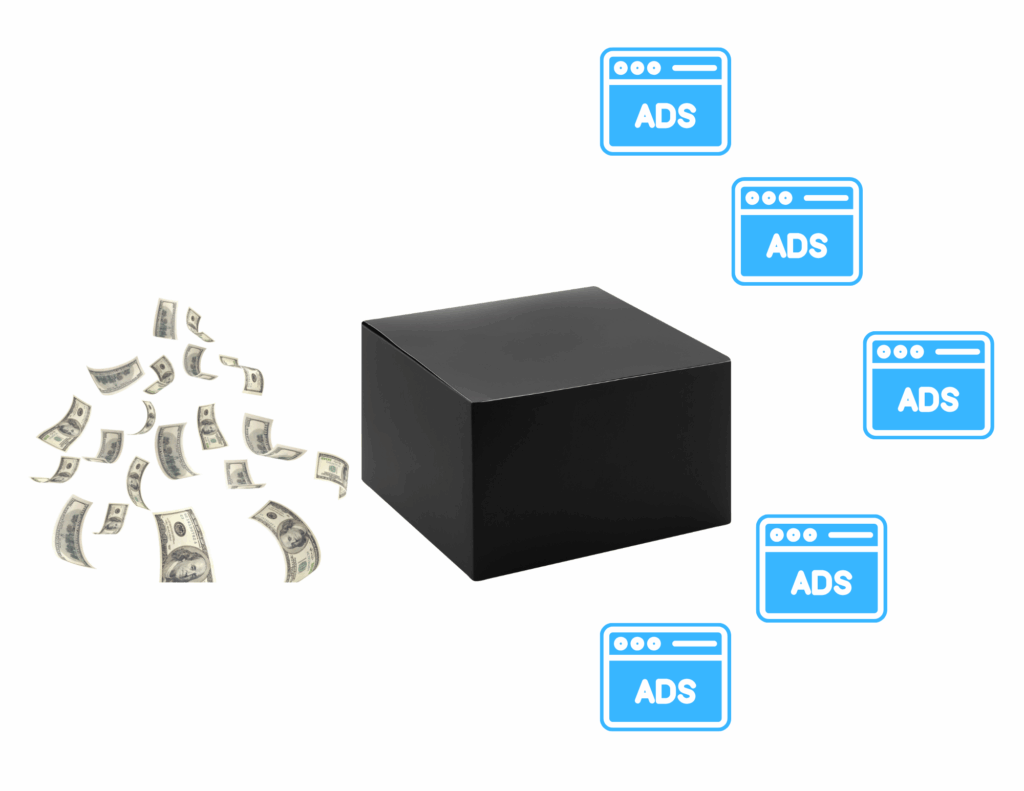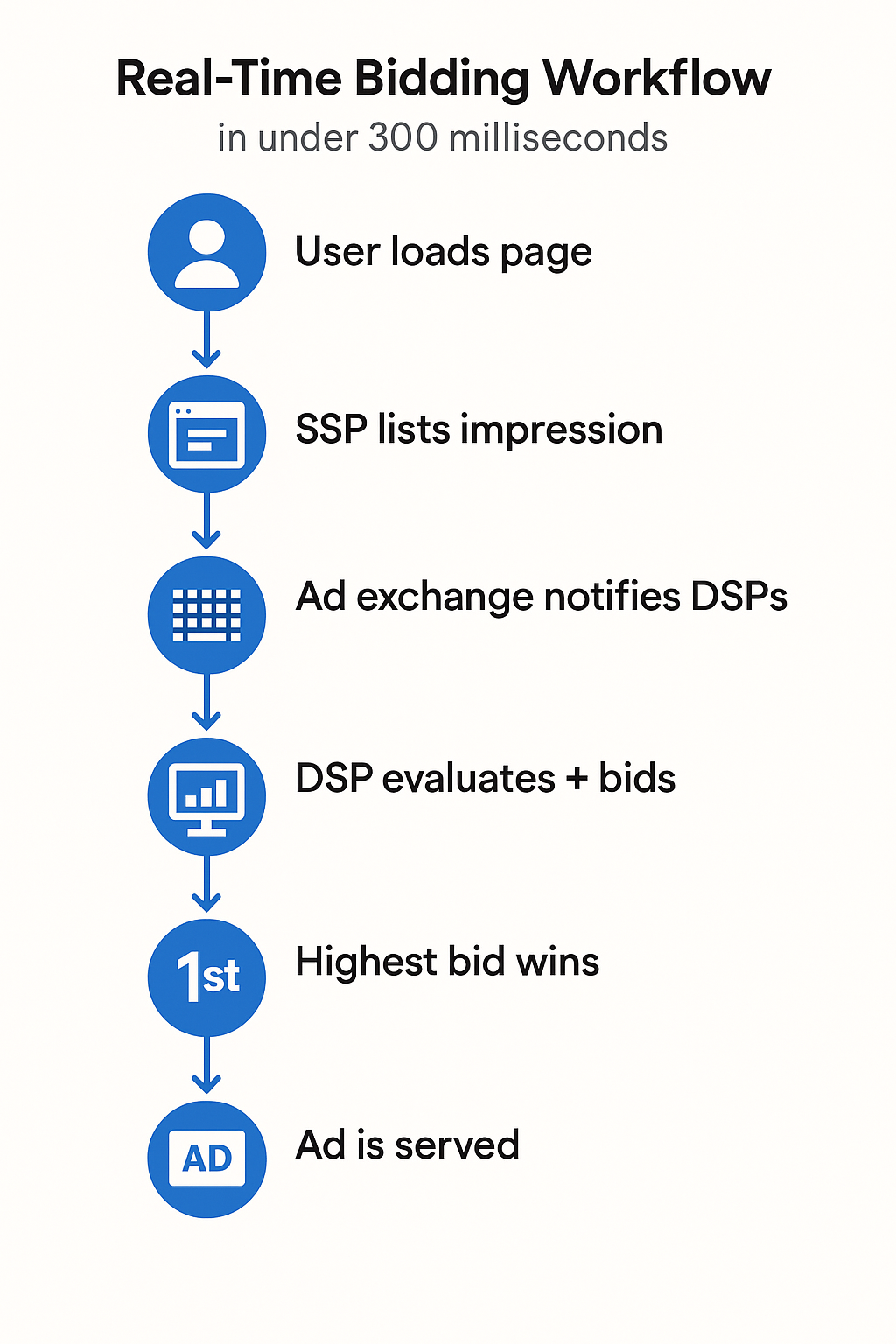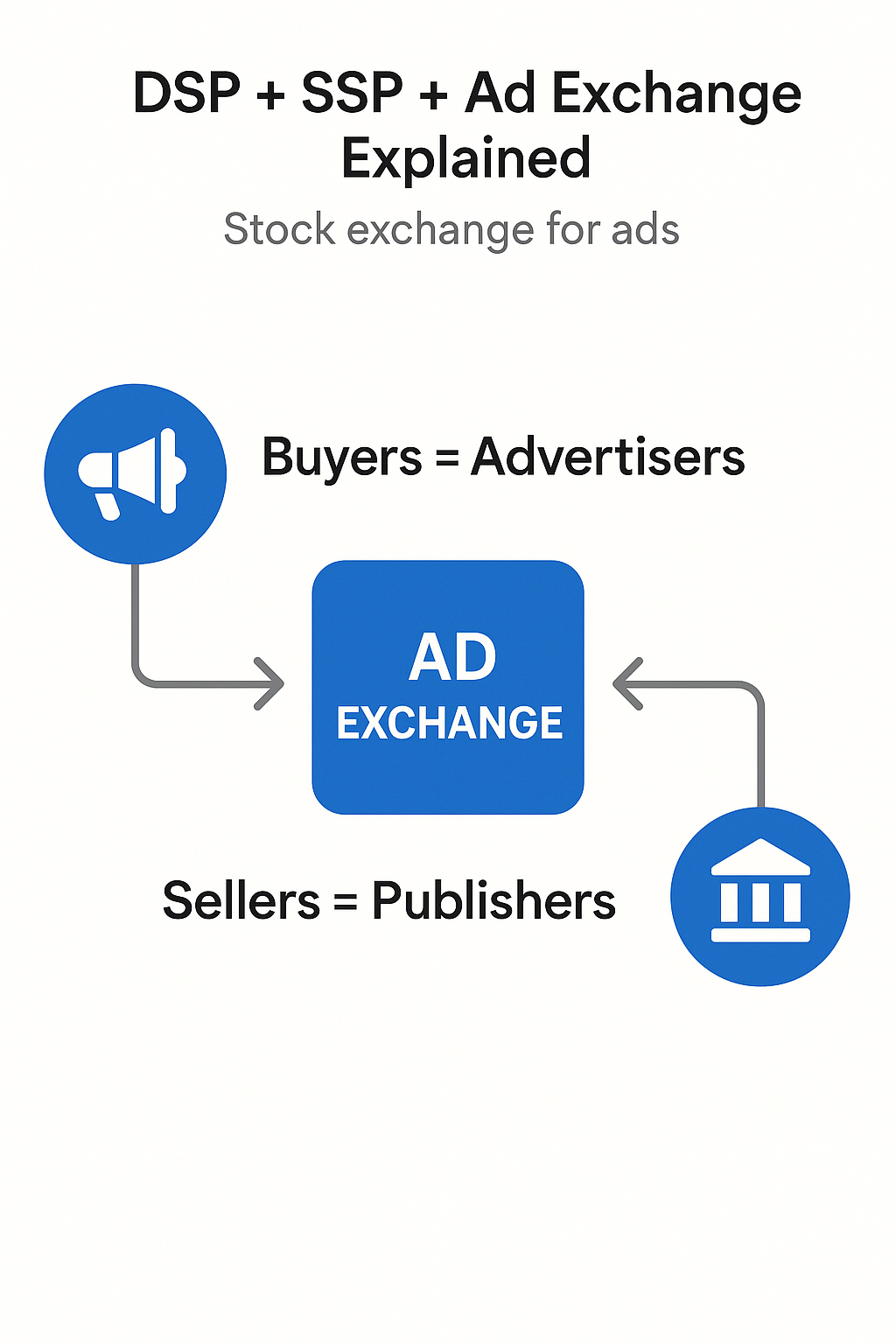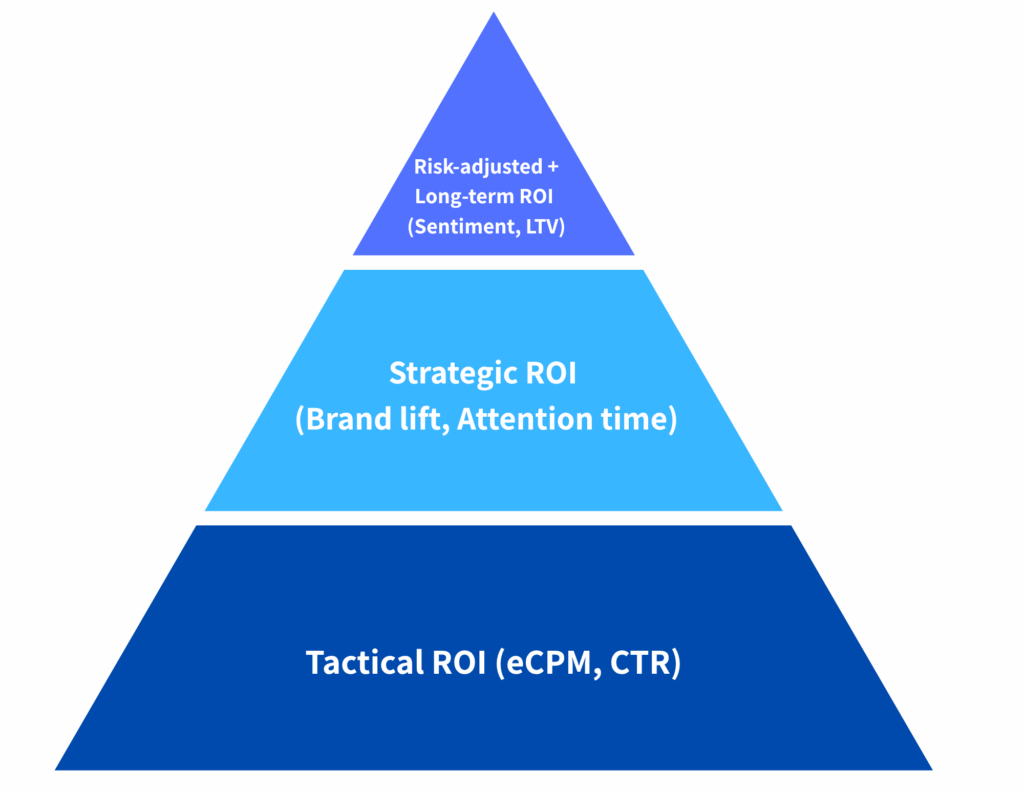Programmatic Advertising 101: A Simplified Guide To Automated Digital Advertising

Table of Contents
- Introduction
- Key Takeaways: The Strategic Framework
- What Is Programmatic Advertising?
- How It Works: The Players in the Game
- When Open Exchanges Work (And When They Don’t)
- The Premium Alternatives: PMPs and Programmatic Guaranteed
- The Strategic Trade-Off
- Case Study: How GSK Used Programmatic Guaranteed to Maximize Brand Impact
- Measuring Success: The ROI Framework
- Action Plan: Making Programmatic Work for Your Brand
- The Future Is Intentional Automation
- Conclusion
- An Introductory Guide to How Programmatic Audio Advertising Actually Works
Introduction
Ask many marketers to explain what happens in the 300 milliseconds between someone loading a webpage and an ad appearing, and you’ll get a lot of creative hand-waving. We’ve built a $200+ billion advertising ecosystem that many marketers treat like a magic black box: you feed money in and hope good things come out.
But here’s the problem: In 2023, the Association of National Advertisers (ANA) discovered that 23% of programmatic ad spend was being wasted, with 15% going to “clickbait websites instead of premium inventory”. Ad fraud cost advertisers $20 billion globally that year, with most of it flowing through automated buying systems that promised efficiency but delivered deception via ineffective ad placements on bad websites.
Everyone uses programmatic. Everyone claims to “get it.” But scratch beneath the surface, and you’ll find a system so complex that many seasoned marketers can’t explain what actually happens in those crucial milliseconds.
This is a straightforward guide to understanding what programmatic actually is, how it really works, and, most importantly, why the difference between smart programmatic and lazy programmatic could make or break your brand.
Key Takeaways: The Strategic Framework
Before we go further, here’s what you need to know about your programmatic options:
| Model | Brand Safety | Transparency | Control | Scale | Cost |
| Open Exchange (RTB) | Low | Low | Low | High | Low |
| Private Marketplace | Medium–High | Medium–High | Medium | Medium | Medium |
| Programmatic Guaranteed | High | High | High | Lower | High |
The strategic choice isn’t just about cost. It’s about matching your buying approach to your campaign goals and brand risk tolerance.
What Is Programmatic Advertising?
Strip away the jargon, and programmatic advertising boils down to this:
It’s the automated buying and selling of digital advertising space, like a stock exchange for attention.
Instead of the old-school approach (think: endless email chains, insertion orders, RFP’s, and quick agency lunches), programmatic uses algorithms to handle transactions in real-time. We’re talking milliseconds.
An algorithm decides whether your brand should bid on showing an ad to someone loading a webpage, evaluates hundreds of data points, places a bid, wins or loses the auction, and serves the ad, all before the page finishes loading.

The speed and automation translate into massive efficiency gains. That’s why over 90% of digital ad spending in the US now flows through programmatic channels.
How It Works: The Players in the Game
To understand programmatic, it helps to picture it like a stock exchange; except instead of trading shares, you’re trading impressions.
There are three main components:
1. Demand Side Platforms (DSPs):
These are the tools advertisers use to bid on and buy ad space. Your DSP is constantly evaluating available ad inventory, checking it against your campaign parameters (budget, targeting, goals), and deciding whether to bid. It’s fed by a Data Management Platform (DMP) that provides the audience data to make smart targeting decisions.
2.Supply Side Platforms (SSPs):
These are used by publishers (websites, apps, audio platforms, or even digital billboards) to sell their ad inventory. If you own a site or an app, the SSP is what lists your ad inventory for auction. The SSP puts impressions up for auction, allowing multiple advertisers to compete.
3.Ad Exchange:
This is the neutral marketplace where the actual transaction happens. Think of it as a stock exchange for ad impressions. The DSPs and SSPs plug into the ad exchange, which matches supply and demand in real-time. It’s Wall Street for ad impressions.

The dominant model within this ecosystem is Real-Time Bidding (RTB), an open marketplace model where advertisers set a maximum bid and let the DSP algorithms compete for the best price. Highest bid wins. It’s fast, efficient, and scalable. It’s also where things can go spectacularly wrong if you’re not careful.
When Open Exchanges Work (And When They Don’t)
RTB Makes Sense For:
- Performance campaigns focused on volume and efficiency
- Testing new audiences or creative concepts
- Customer acquisition with clear conversion goals
- Campaigns with flexible brand safety requirements
- Campaigns with limited budgets where premium inventory costs are prohibitive
RTB Becomes Problematic For:
- Brand awareness campaigns
- Product launches
- Premium brand positioning
- Industries with strict compliance requirements
- Campaigns where context matters as much as reach
Real-Time Bidding may be the workhorse of programmatic, but it’s not without baggage; namely, brand safety, transparency, and control. If you’ve ever had your ad show up on a sketchy site or next to polarizing content, you’ve seen the downside of open exchange buys.
Consider what happened to Uber in 2020: Uber discovered that a significant portion of its app installs attributed to programmatic ads were actually organic installs or fraudulent. This led Uber to turn off $100 million in ad spend and sue several ad networks for buying non-existent, non-viewable, or fraudulent advertising.
Open exchanges optimize for scale and efficiency, not brand safety or quality. Your ad can end up in some truly questionable neighborhoods: low-quality sites, controversial content, or outright fraud schemes. Even with safeguards like blocklists and brand safety filters, the system is vast and imperfect.
This is where Private Marketplaces (PMPs) and Programmatic Guaranteed (PG) deals become essential: as precision tools for marketers who want both automation and accountability.
The Premium Alternatives: PMPs and Programmatic Guaranteed
Private Marketplaces (PMPs): Curated Access
PMPs offer invitation-only access to premium inventory. Instead of bidding against the entire internet, you compete with a select group of vetted advertisers for space on handpicked, brand-safe properties. This gives you more control over where your ads appear.
Think of it like this: Instead of buying a random billboard on any highway, you’re getting invited to bid on billboards in Times Square, and only premium brands are allowed to participate.
What you get:
- Curated supply from trusted publishers (The New York Times, Vox Media, NPR, Spotify, etc)
- Quality control with limited third-party reselling or sketchy arbitrage
- More transparency about where your ads actually appear
- Protection from the long tail of questionable inventory
PMP = Curated supply + Vetted audience + Actual transparency
Programmatic Guaranteed: Direct Deals, Automated
PG takes it one step further. This is a one-to-one deal where pricing and inventory are pre-negotiated. This is the safest route. You’re essentially automating a direct deal with a premium publisher with pre-negotiated terms.
There’s no bidding war, no surprises, no wondering where your ad will show up. You negotiate placement, audience, timing, and cost upfront. Then automation handles the execution. Since it’s a one-to-one relationship, you can ensure content alignment, timing, placement, and audience specificity, before a single impression is served.
What you get:
- Guaranteed placement with fixed CPMs
- Full publisher collaboration on content alignment
- Complete transparency about ad placement
- Maximum control over brand safety and context
PG = Guaranteed placement + Publisher partnership + Zero surprises.
The Strategic Trade-Off
Transparency in programmatic boils down to knowing what you’re buying, from whom, and how much of your ad spend is actually working. PMPs and PG both improve this significantly.
What you gain:
- Visibility into publishers and placements: Unlike the open exchange where some supply paths are murky, these deals give you full clarity on which publisher and often which pages or sections your ads will appear on.
- Fee transparency: In PG deals especially, you know exactly what portion of your spend goes to media vs. tech fees, which are often hidden in open auctions.
- Audience Quality: PMPs allow you to combine first-party publisher data with your own, creating higher-fidelity audience targeting with less reliance on third-party cookies.
What You Give Up:
- Scale: Premium inventory is limited compared to open exchanges
- Cost Efficiency: CPMs are typically 2-5x higher than RTB
- Flexibility: Less ability to quickly shift budgets or test new audiences
What this means for premium campaigns:
- You can enforce contextual alignment (your brand next to relevant, uplifting, or authoritative content).
- You can ensure frequency caps, ad experience standards, and measurement frameworks that match your brand goals.
- You can push for log-level data and post-campaign breakdowns to truly understand ROI.
This matters not just for performance, but for planning. When you understand where your ads are running and how they’re performing, down to the impression, you can budget more intelligently and iterate with purpose.
Case Study: How GSK Used Programmatic Guaranteed to Maximize Brand Impact
GlaxoSmithKline (GSK) faced a clear challenge: they were running awareness campaigns through open exchange programmatic video (RTB), but the results were inconsistent. “”Faceless” was the word most often applied when consumers were asked to describe the company”
The issue? GSK’s ads were appearing next to questionable content and low-quality inventory, undermining the emotional storytelling they were paying a premium to produce.
The Solution:
GSK shifted its high-impact video campaign from RTB to Programmatic Guaranteed (PG) deals with premium publishers like Time, Reuters, and HuffPost. The goal was controlled placement, fixed CPM pricing, and reserved inventory that aligned with the brand’s quality standards and messaging.
The Results:
- View-through rate (VTR) reached 66%, above industry average
- Cost per view of $0.04
- Reached over 8 million unique viewers in verified brand-safe environments
- Significant uplift in brand sentiment and aided awareness.
Per Kelly O’Callaghan, GSK’s vice president of global brand, “we saw a significant shift in public perception.”
The Lesson?
GSK proved that moving away from RTB’s volatility, and paying a premium for context, can lead to better cost-efficiency and far stronger brand outcomes.
Measuring Success: The ROI Framework
So how do you actually measure the value of PG compared to open exchange buys?
If you’re doing internal reporting or building a case for PG investment, quantify ROI in tiers:
- Immediate Return: eCPM, CPCV, CTR
- Strategic Return: Brand lift, viewability, engagement quality
- Risk-Adjusted Return: Ad fraud avoided, brand safety preserved, cost of bad placements eliminated
- Long-Term Return: Improved sentiment, loyalty, Lifetime Value (LTV) from trusted placements

The trick is not to look for a single ROI number. Instead, you build a layered view, one that captures performance, efficiency, brand impact, and strategic control:
1. Performance Metrics (Immediate Return)
- Viewability Rate (VTR): PG often delivers higher viewability—ads are placed where users actually see them. PG placements usually get seen. Not skimmed. Not scrolled past.
- Completion Rate: For video or audio, PG placements tend to drive higher full-play rates.
- Click-Through Rate (CTR): RTB may show higher raw CTR (inflated by accidental clicks and bot traffic), but PG delivers more intentional engagement and clicks.
2. Efficiency Metrics (Cost Clarity)
- Effective CPM (eCPM): Factor in waste, fraud, and hidden fees—PG often wins on true efficiency despite higher upfront costs.
- Cost per Completed View (CPCV) or Cost per Engagement (CPE): What you actually pay for genuine attention, not just served impressions.
Invalid Traffic Rate (IVT): PG offers cleaner inventory: less fraud, fewer bots, lower noise.
3. Brand Impact Metrics (Strategic Return)
- Brand Lift: Measured via pre/post studies, PG tends to deliver higher lift in awareness, favorability, and intent, compared to open exchanges..
- Attention Time: Longer dwell time in premium, less cluttered environments.
- Sentiment Alignment: Ads appear in contexts that reflect well on your brand; not random corners of the web. That matters.
4. Risk-Adjusted Metrics (Long-term Protection)
- Supply Path Transparency (SPT): Fewer intermediaries mean more of your spend reaches actual media instead of middleman fees.
- Placement Verification: You know exactly where your ad ran, with detailed reporting down to the URL level, and where it didn’t.
- Fraud Avoidance: Calculate the cost of fraudulent traffic you’re not buying
- Audience Match Quality: PG deals often allow for better data matching, with higher match rates when combining first-party data.
Performance Comparison Table
| Metric Type | RTB (Open Exchange) | Programmatic Guaranteed |
| CPM | Lower | Higher but predictable |
| Viewability | Variable | High and often guaranteed |
| Completion Rate | Medium | High |
| CTR | Often higher | More intentional |
| Invalid Traffic | Higher | Lower |
| Brand Lift | Inconsistent | Consistently strong |
| Attention Time | Shorter | Longer |
| Placement Transparency | Limited | Full |
| Sentiment Safety | Uncontrolled | Controlled |
Action Plan: Making Programmatic Work for Your Brand
Here’s your strategic roadmap:
1. Audit Your Current Mix
- Immediate: Analyze what percentage of your programmatic spend goes to open RTB vs. curated deals
- Deep dive: Request supply path transparency reports from your DSP to see where your money actually goes
- Brand safety check: Audit recent placements for any questionable or off-brand appearances
2. Implement Tiered Buying Strategy
- Performance campaigns: Continue using RTB for volume and efficiency
- Brand campaigns: Shift to 60-70% PMPs/PG for premium environments
- Product launches: Use 80-90% PG deals for maximum control and brand safety
3. Upgrade Your Measurement
- Install layered ROI tracking: Performance + Brand + Risk-adjusted metrics
- Demand log-level data: Negotiate with your DSP for impression-level reporting
- Implement brand lift studies: Measure actual impact, not just engagement
4. Invest in Creative That Cuts Through
- Context-aware creative: Different messages for different environments
- Dynamic optimization: Use programmatic speed for creative testing
- Quality over quantity: Better to have 10 great ads than 100 mediocre ones
5. Build First-Party Data Intelligence
- Audience development: Create lookalike audiences from your best customers
- Publisher partnerships: Combine your data with premium publisher insights
- Future-proofing: Develop targeting strategies that don’t rely on third-party cookies
6. Make Transparency Non-Negotiable
- Supply path audits: Understand every intermediary taking a cut
- Fee transparency: Know exactly what you’re paying for media vs. tech
- Performance verification: Use third-party measurement for accountability
Questions to Ask Your DSP:
- What’s our average supply path length, and how can we shorten it?
- Which PMPs have the highest performance for our verticals?
- Can you guarantee minimum viewability rates for PG deals?
- What’s our true effective CPM after all fees and waste?
Questions to Ask Publishers (for PG deals):
- What audience data can you provide for better targeting?
- Can you guarantee ad placement above the fold?
- What content categories will you exclude for our brand?
- What’s your average time-on-page for our target audience?
The Future Is Intentional Automation
The programmatic advertising landscape is evolving rapidly. Privacy regulations are tightening. Third-party cookies are disappearing. Ad fraud is getting more sophisticated. The brands that will thrive are those that combine automation with intention.
We’re moving toward a world where successful programmatic isn’t about buying the most impressions at the lowest cost. It’s about buying the right impressions from the right publishers for the right audiences with the right creative at the right price.
The future belongs to marketers who understand that programmatic is a tool, not a strategy. The strategy is knowing your customers, choosing environments that amplify your brand, and measuring what actually matters to your business.
Conclusion
Programmatic advertising is the backbone of modern digital media. Its appeal lies in automation, speed, cost-effectiveness, and scale. But its success depends on strategy, not just software.
The brands that win in programmatic don’t just plug in and press go. They craft campaigns that are automated AND intentional, efficient AND effective, scaled AND strategic.
Stop treating programmatic like a black box. Start treating it like the sophisticated tool it actually is. Your brand, and your budget, will thank you.
Your Next Steps
Ready to optimize your programmatic strategy? Start with an audit of your current mix using the framework above. Identify one brand campaign that could benefit from moving to PMPs or PG deals, and test the difference in performance, brand safety, and ROI.
The goal isn’t to abandon RTB entirely. It’s to use the right tool for the right job. Match your buying strategy to your campaign objectives, and watch your programmatic performance transform from automated spending to strategic investment.
TLDR
- Don’t default to open RTB out of habit. For anything touching your brand equity, consider PMPs or PG deals.
- Measure what matters. Build layered ROI analysis that captures performance, brand impact, and strategic control.
- Invest in creative that cuts through. All the targeting sophistication in the world won’t save boring ads.
- Use first-party data intelligently. The future belongs to brands that understand their customers deeply, not just broadly.
- Treat transparency as non-negotiable. Know where your ads run, who sees them, and what you’re actually paying for.